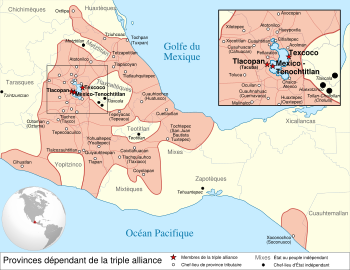Tlaxcala (Nahua state) facts for kids
Quick facts for kids
Confederacy of Tlaxcala
Tlahtōlōyān Tlaxcallan
|
|||||||||||||||
|---|---|---|---|---|---|---|---|---|---|---|---|---|---|---|---|
| 1348–1520 | |||||||||||||||
|
Battle vexilloid worn by Tlaxcalan warriors who fought alongside the Spanish (Lienzo de Tlaxcala)
|
|||||||||||||||

Tlaxcala was surrounded by the Aztec Empire in 1519.
|
|||||||||||||||
| Capital | Tlaxcala | ||||||||||||||
| Common languages | Official language: Nahuatl | ||||||||||||||
| Religion | Aztec religion | ||||||||||||||
| Government | Confederation | ||||||||||||||
| Tlatoani of Tlaxcala | |||||||||||||||
|
• 1348
|
Culhuatecuhtli | ||||||||||||||
| Historical era | Post Classic /Early Modern | ||||||||||||||
|
• The Tlaxcalla People Migrate to Central Mexico
|
1348 | ||||||||||||||
| 1520 | |||||||||||||||
| Population | |||||||||||||||
|
• 1348
|
? | ||||||||||||||
|
• early 15th century
|
650,000 | ||||||||||||||
|
• 1519
|
300,000 | ||||||||||||||
| Currency | Quachtli, Cacao | ||||||||||||||
|
|||||||||||||||
| Today part of | Mexico | ||||||||||||||
Tlaxcala (Classical Nahuatl: Tlaxcallān [tɬaʃ.ˈká.lːaːn̥] 'place of maize tortillas') was an important city and state in central Mexico before the arrival of Europeans. It was a powerful independent area that the Aztec Empire could never conquer.
During the Spanish conquest of the Aztec Empire, Tlaxcala became a key ally of the Spanish Empire. Tlaxcalan warriors made up a large part of the army that helped the Spanish defeat the Aztecs.
Tlaxcala was completely surrounded by Aztec lands. This led to ongoing conflicts, sometimes called "flower wars." These wars were fought because the Aztecs wanted to take over Tlaxcala, but the Tlaxcalans bravely fought to stay independent.
Contents
History of Tlaxcala

The top-right section is Tizatlan, bottom-right Quiahuiztlan, top-left Ocotelolco, and bottom-left Tepeticpac. The Atzompa River flows through the city from north to south.

The Tlaxcalans arrived in central Mexico during a time known as the Late Postclassic period. They first settled near Texcoco in the valley of Mexico.
After some time, the Tlaxcalans were forced to leave the valley of Mexico. They moved east and split into three groups. One group went north, another stayed near Texcoco, and a third group settled in the area that is now Tlaxcala. Here, they built the city of Tepetícpac Texcallan, led by Culhuatecuhtli Quanex.
Over the years, the Tlaxcalan state grew. They founded other major settlements like Ocotelulco and Tizatlán. The fourth main settlement, Quiahuiztlan, was started by Tlaxcalans who had stayed in the valley of Mexico for a while longer.
How Tlaxcala Was Governed
Ancient Tlaxcala was a republic, which means it was ruled by elected or chosen officials, not a king. A council of 50 to 200 important political leaders, called teteuctin, made the decisions.
These leaders earned their positions by serving the state, especially through success in warfare. Because of this, both noble people (called pilli) and common people (called macehualli) could become leaders.
Tlaxcala and the Spanish Conquistadors
Tlaxcala was never conquered by the Aztec empire. Instead, they were in a constant state of war with the Aztecs, known as the "flower wars." These were ritual battles, but they also helped train warriors and capture prisoners.
When the Spanish conquistador Bernal Díaz del Castillo wrote about the first battle between the Spanish and the Tlaxcalans, he said it was very difficult. He believed the Spanish might not have survived if not for two important Tlaxcalan leaders, Xicotencatl the Elder and Maxixcatzin. They convinced Xicotencatl the Younger, who was the Tlaxcalan war leader, that it would be better to join forces with the Spanish newcomers than to fight them.
Later, Xicotencatl the Younger was accused of leaving his post by the Tlaxcalan ruling council. He was then hanged by Hernán Cortés in April 1521, during the siege of Tenochtitlan (the Aztec capital).
Because of their long-standing conflict with the Aztecs, the Tlaxcalans were very eager to get revenge. They quickly became loyal allies of the Spanish. Even after the Spanish were temporarily driven out of Tenochtitlan, the Tlaxcalans continued to support their efforts to conquer the Aztec Empire. Tlaxcala also helped the Spanish in their conquest of Guatemala.
Special Status After the Conquest
As a result of their strong alliance with the Spanish, Tlaxcala received special treatment in Spanish colonial Mexico. They were given a privileged status, similar to that of Spanish nobles (called hidalgo).
After the Spanish conquered Tenochtitlan and the rest of Mexico, Tlaxcala was allowed to keep its pre-Columbian culture. Also, as a reward for their loyalty, the city and its people were mostly spared from the looting and destruction that followed the Spanish conquest. The Tlaxcalans continued to help the Spanish, even assisting them in the Mixtón War.
After the Spanish conquest, in 1545, Tlaxcala was divided into four main areas called señoríos (fiefdoms) by the Spanish official Gómez de Santillán. These areas were Ocotelolco, Quiahuiztlan, Tepeticpac, and Tizatlan. At this time, four powerful families claimed to have inherited rights to each of these areas. They even created fake family histories to prove their claims went back to before the Spanish arrived.
During the time when Mexico was a Spanish colony, Tlaxcala's role in helping conquer the Aztec Empire, its special treatment from the Spanish king, and its skill in promoting itself and arguing its case, gave this small state an important place in Mexican history.
In the 16th and 17th centuries, Tlaxcalan settlers moved to new colonies in northern Mexico. They helped protect these areas from other groups like the Chichimecas.
See also
 In Spanish: República de Tlaxcallan para niños
In Spanish: República de Tlaxcallan para niños
- Tlaxcaltec – This is the Nahuatl word for the people who lived in Tlaxcala.
- Tlaxcala – This is the name of the Mexican state today.
- Tlaxcala, Tlaxcala – This is the name of the capital city of the state of Tlaxcala today.




